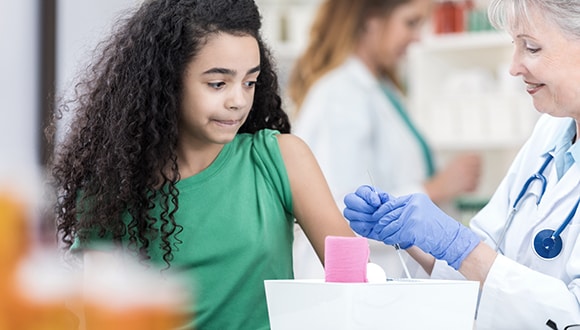A new weapon against cervical cancer
A vaccine shown to reduce rates of cervical cancer has been released in Australia. Here’s what you need to know.
Health Agenda magazine
January 2018
Research has found that cervical cancer could be greatly reduced in the future, thanks to a new vaccine released in Australia in 2018.
Already available in the USA and New Zealand, Gardasil 9 became part of Australia’s school-based National Immunisation Program from 1 January this year.
The previous vaccine, which was available free of charge to girls and boys aged 12 to 13 years under the National HPV Vaccination Program, protected against 4 HPV types and 70% of all cervical cancer cases.
The new vaccine prevents 9 strains of HPV that cause 93% of cervical cancers – a further 23% cancer protection compared to the existing Gardasil vaccine, according to research led by the Royal Women’s Hospital in Melbourne.
The dose requirement has also changed, with the old vaccine needing 3 doses to take full effect, but the new vaccine only requiring 2 doses if administered before the age of 14.
It’s most effective if given to those not yet sexually active. If you’re an adult who wasn’t included in the HPV vaccination program, you can ask your doctor whether the vaccination would be beneficial for you.

What does HPV stand for?
HPV stands for human papillomavirus, a common virus – so common, in fact, that it’s thought 4 out of 5 Aussies will have a type of HPV at some stage in their life. In most cases, it will go undetected. There are around 200 types of HPV and usually our bodies flush out the virus. HPV types 16 and 18 are the most commonly associated with cervical cancer, according the US National Cancer Institute.
Will I still need to be screened for cervical cancer?
Yes. Although the vaccine does have a high rate of protection, it doesn’t protect against 100% of cervical cancers, so all women still need to be screened.
New HPV tests
Until December 2017, women were advised to start having Pap tests from age 18, and to keep having them every 2 years.
Now a more accurate HPV test has been introduced, and women who’ve been sexually active are being advised to start the screening at age 25, and repeat only every 5 years.
For women getting the test, the procedure will seem much the same, but what happens in the lab has become more advanced.
It’s estimated that the new screening test – which detects HPV infections in cells, sometimes before they cause abnormal cells to develop, while a Pap test only identifies abnormal cell changes – will prevent up to an additional 140 cervical cancers a year, according to the Australian Cervical Cancer Foundation.
You can get the HPV test through your GP. For more information on the HPV test and HPV vaccine, visit the Cancer Institute.
Related articles
THE VACCINATION CONVERSATION
When it comes to the health and wellbeing of a child, disagreements within a family can be a problem. Here’s some expert advice on starting the conversation.
THE ANTI-VACCINATION MOVEMENT: MYTHS VS FACTS
It’s a divisive, and emotive, topic. We track the history of the anti-vaccination movement and the potential consequences of under-vaccination.
HEALTH CHECKS BY AGE: THE TESTS YOU SHOULD BE HAVING
Your guide to staying on top of your health, through every stage of life.
SERIOUS CONDITIONS THAT CAN BE MISSED
Many serious conditions have vague or hidden symptoms. Here’s how to identify and screen for them.